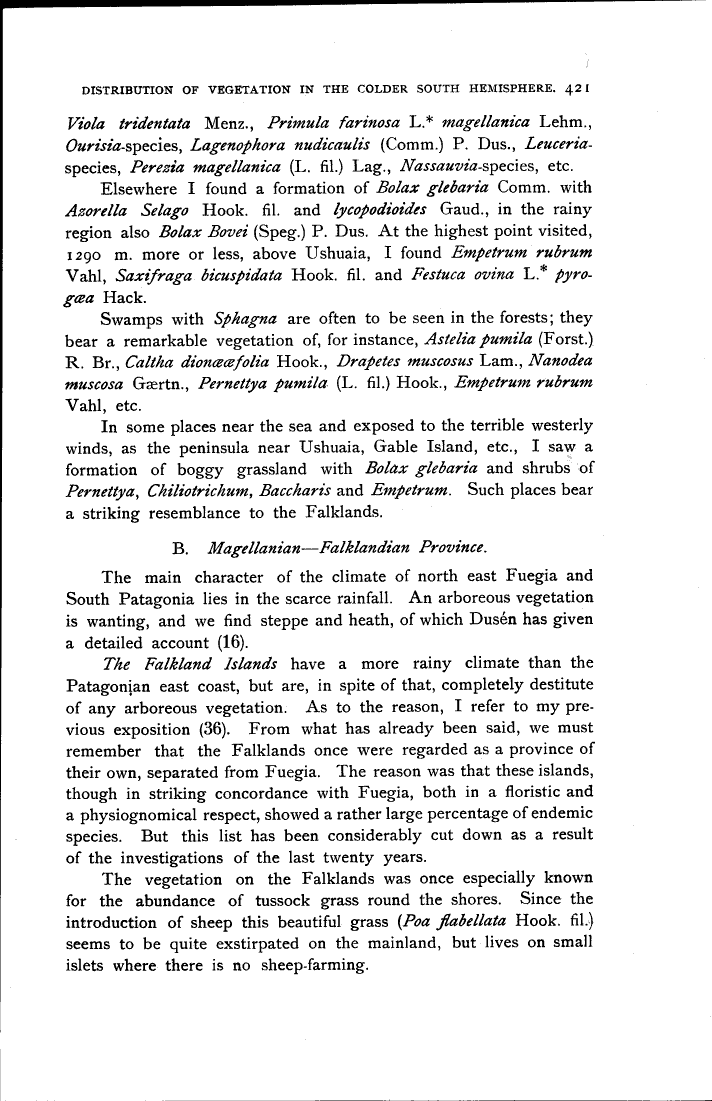
Full resolution (TIFF) - On this page / på denna sida - Some remarks upon the geographical distribution of vegetation in the colder Southern Hemisphere. By Carl Skottsberg. Botanist of the Swedish Antarctic Expedition 1901—1903. With 2 maps, tabl. 8 and 9. - General survey of the austral of or palæooceanic (Engler) realm. - II. The subantarctic dominion. - 1. District of subantarctic South America. - A. South Chilian—Fuegian Province. - B. Magellanian—Falklandian Province.

<< prev. page << föreg. sida << >> nästa sida >> next page >>
Below is the raw OCR text
from the above scanned image.
Do you see an error? Proofread the page now!
Här nedan syns maskintolkade texten från faksimilbilden ovan.
Ser du något fel? Korrekturläs sidan nu!
This page has been proofread at least once.
(diff)
(history)
Denna sida har korrekturlästs minst en gång.
(skillnad)
(historik)
Viola tridentata Menz., Primula farinosa L.* magellanica Lehm.,
Ctøw/ø-species, Lagenophora nudicaulis (Comm.) P. Dus.,
Leuceria-species, Perezia magellanica (L. fil.) Lag., Nassauvta-species, etc.
Elsewhere I found a formation of Bolax glebaria Comm. with
Azor e lia Selago Hook. fil. and lycopodioides Gaud., in the rainy
region also Bolax Bovei (Speg.) P. Dus. At the highest point visited,
1290 m. more or less, above Ushuaia, I found Empetrum rubrum
Vahl, Saxifraga bicuspidata Hook. fil. and Festuca ovina L.*
pyro-gæa Hack.
Swamps with Sphagna are often to be seen in the forests; they
bear a remarkable vegetation of, for instance, Astelia pumila (Först.)
R. Br., Caltha dionææfolia Hook., Drapetes muscosus \^%m.,Nanodea
muscosa Gaertn., Pernettya pumila (L. fil.) Hook., Empetrum rubrum
Vahl, etc.
In some places near the sea and exposed to the terrible westerly
winds, as the peninsula near Ushuaia, Gable Island, etc., I saw a
formation of boggy grassland with Bolax glebaria and shrubs of
Pernettya, Chiliotrichum, Baccharis and Empetrum. Such places bear
a striking resemblance to the Falklands.
B. Magellanian—Falklandian Province.
The main character of the climate of north east Fuegia and
South Patagonia lies in the scarce rainfall. An arboreous vegetation
is wanting, and we find steppe and heath, of which Dusen has given
a detailed account (16).
The Falkland Islands have a more rainy climate than the
Patagonian east coast, but are, in spite of that, completely destitute
of any arboreous vegetation. As to the reason, I refer to my
previous exposition (36). From what has already been said, we must
remember that the Falklands once were regarded as a province of
their own, separated from Fuegia. The reason was that these islands,
though in striking concordance with Fuegia, both in a floristic and
a physiognomical respect, showed a rather large percentage of endemic
species. But this list has been considerably cut down as a result
of the investigations of the last twenty years.
The vegetation on the Falklands was once especially known
for the abundance of tussock grass round the shores. Since the
introduction of sheep this beautiful grass (Poa flabellata Hook, fil.)
seems to be quite exstirpated on the mainland, but lives on small
islets where there is no sheep-farming.
<< prev. page << föreg. sida << >> nästa sida >> next page >>